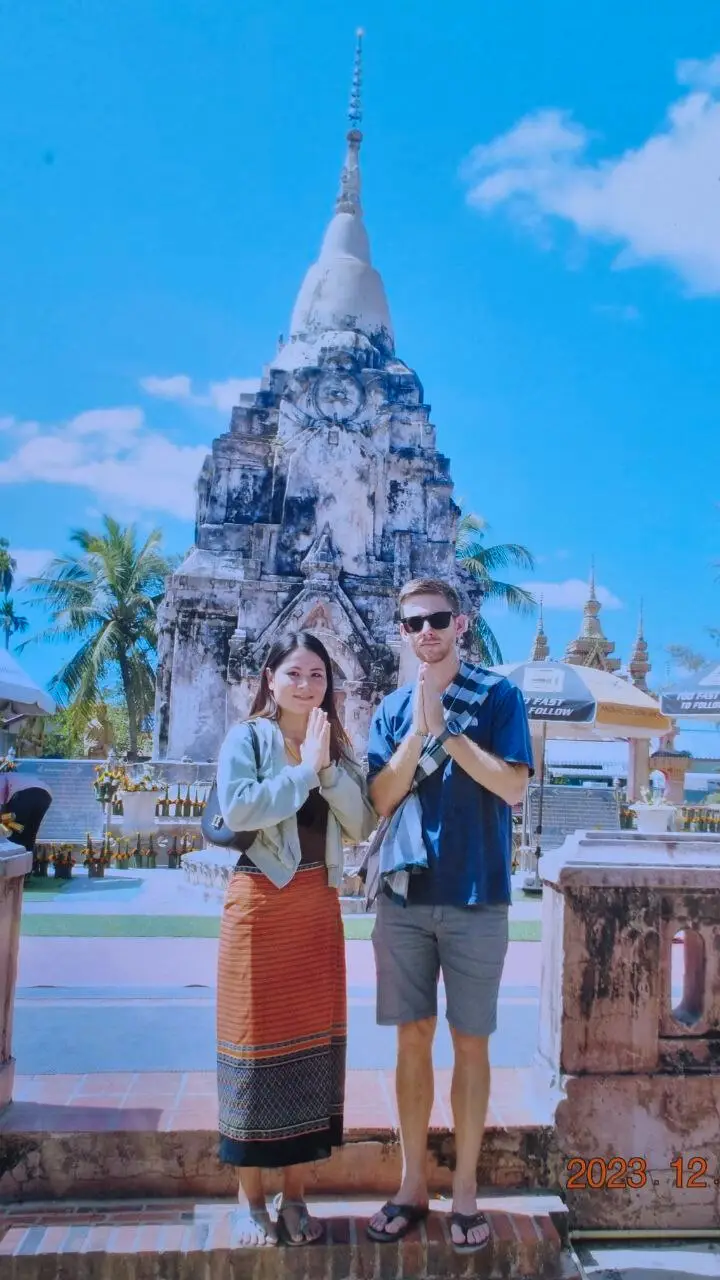
Disclosure: This article contains affiliate links. If you make a purchase through them, we may earn a small commission and you support our blog – at no extra cost to you.

Savannakhet, a city and province of the Central Region of Laos is among the less known destinations for tourists, but an absolute hidden gem. The central district of the city Savannakhet itself is actually called “Kaysone Phomvihane City” – named after the first leader of the Lao People’s Revolutionary Party (LPRP) and he also served as the first prime minster of the Laos PDR. Most of the people who have ever been in Laos, will probably know his face as he’s the one printed on all the banknotes of the local currency the laotian kip. The city has a very local, but also french colonial old town charme with many influences from past times.
Savannakhet is also often referred to simply as “Savan,” (translates to Heaven in lao language) is the second-largest city in Laos and a fascinating mix of old-world charm and modern bustle. Located on the banks of the Mekong River bordering Mukdahan in Thailand, it has long served as a strategic trading hub, drawing influence from its neighboring countries and early French colonialists. Today, many parts of that colonial past remain in the form of French-style architecture and cultural landmarks. The city offers a mix of Lao, French & Vietnamese influence, making it a unique, sleepy, but exciting town on the Mekong river.
During the Vietnam War (1955–1975), Savannakhet’s strategic position along the Mekong River and its proximity to both Thailand and Vietnam placed it squarely in the broader regional conflict. Although Laos was officially neutral, the country became heavily involved due to the covert wars fought within its borders. Here are some key points about Savannakhet’s role and experience during that period:
Proximity to the Ho Chi Minh Trail
Parts of Savannakhet Province lay near or intersected supply routes used by the North Vietnamese, making the area a vital corridor for moving troops and materiel. These covert pathways—the Ho Chi Minh Trail—ran through rugged terrain in eastern Laos, and surrounding provinces like Savannakhet were pivotal in supporting or disrupting this flow.
Refugees and Displacement
As conflict escalated, many rural villagers fled areas of intense fighting or bombing and sought relative safety in more urban centers like Savannakhet. This influx of displaced people shaped the city’s demographic and social landscape during the war years.
Covert Operations and Bombings
Despite Laos’s official neutrality, U.S. operations targeted parts of the country to cut off North Vietnamese supply lines, resulting in widespread bombing in eastern Laos. Though the heaviest bombing was concentrated elsewhere, Savannakhet’s province still experienced aerial raids and the broader impact of war, such as damaged infrastructure.
Logistics and Cross-Border Movement
Savannakhet’s role as a trade hub along the Mekong made it useful not only to local commerce but also for clandestine military logistics. Its location across from Thailand’s Mukdahan Province offered critical crossing points for supplies and personnel.
Lingering Impact
The conflict left behind unexploded ordnance and other remnants of war, which continue to affect parts of Savannakhet Province. Efforts to clear these remnants and support affected communities have been ongoing since the war ended, reflecting the enduring legacy of the conflict.
Most of the people who heard about Savannakhet or even have already been to Laos’s second-largest city, it’s probably because of the fact that there is a Royal Thai Embassy in Savannakhet. Therefore the City became popular for visa runners and border bouncers from Thailand, who wish to renew their Thai visa. That’s why many people come only for a few days until their visa is done, before then crossing back over the second Thai-Lao Friendship Bridge to Mukdahan, Thailand.
Another fact to mention is, that the border to Vietnam in the east, draws some people to the town. There is a daily sleeper bus from Savannakhet Bus Station going to Da Nang in Vietnam. The comfortable and cheap bus takes around 10-12 hours to Da Nang and crosses the Lao-Bao border in Dansavan. If you want to catch the bus to Vietnam, just show up at the Bus Station in Savannakhet in the morning around 8 am. Tickets can be purchased there and it’s not neccessary to purchase tickets before (might be even not possible). So showing up at the bus station is your best bet to get the Bus. The price depends on where you are going. If going all the way to Da Nang, the price is somewhat between 20 – 30 USD and can be paid in lao kip at the bus station.
As of January 2025, there is no visa on arrival for Vietnam available at Lao-Bao Border. Tourists planning to visit Vietnam should therefore check the visa requirements before departing and get en eVisa on the official Website. Vice versa there is a Visa on Arrival for Laos available for travelers coming from Vietnam going to the Lao PDR. The general advice for a Lao VOA (visa on arrival) is to have 40 USD in crisp banknotes ready. Sometimes land border checkpoints also collecting a small “service fee”, just keep that in mind as well.
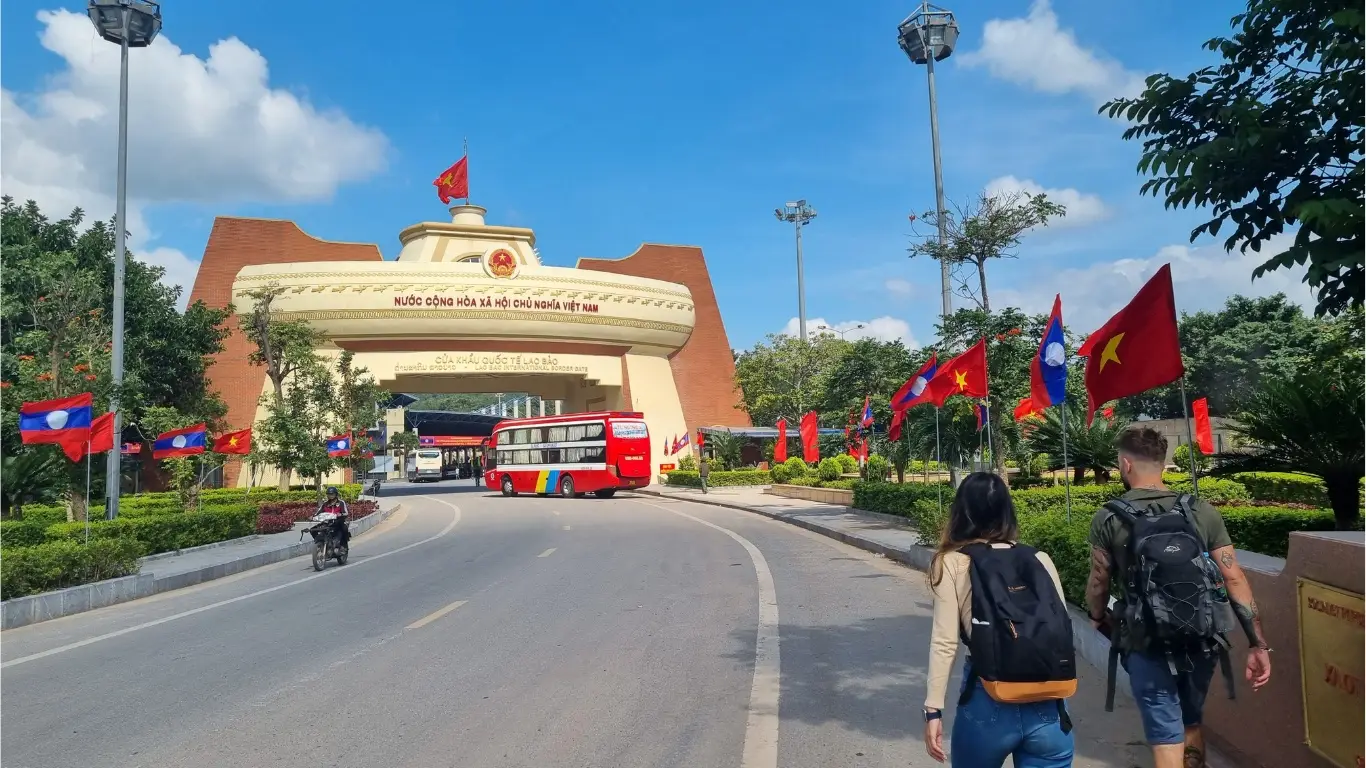
Basically there are four main options how to get to Savannakhet, depends on where your starting point is:
Savannakhet is very laid-back and once arrived at the city, it’s time to go with the flow. It might not be as exciting as places like Luang Prabang, but it’s definitely a very authentic and typical lao city, where you will find yourself mostly among locals instead of other tourists. If you have a few spare days on the way down south to 4000 islands or up to Thakek and ask yourself if it is worth to stop there, then rest assured because the answer is yes! Savannakhet has plenty of things to keep you busy for some days.
Located right on the Mekong River, this night market in Savannakhet can definitely compete with markets in Thailand. Lots of delicious sweet and savoury food, paired with the most famous Beerlao, makes it a great spot to have dinner or a snack and a couple of beers. Believe it or not, but you might even meet other travelers and expats as it’s a popular spot for both locals and foreigners. The market opens around 5 pm until 10 pm. On weekends, the market becomes livelier with live music and traditional dance performances, providing a glimpse into local culture. Visitors can also browse stalls selling local handicrafts, traditional clothing, and souvenirs, reflecting the rich cultural heritage of the Lao people. Its central location along the Mekong River provides scenic views, especially during sunset, making it a picturesque spot for evening strolls. The market is located in the old french colonial theatre, which is still very preserved to get an authentic feeling of the old colonial times.

The Savannakhet Dinosaur Museum offers visitors a glimpse into the region’s prehistoric past. Established to showcase fossils discovered in the area, the museum features exhibits that highlight the ancient creatures that once roamed present-day Savannakhet. While the museum is modest in size, it provides educational insights into paleontological findings specific to Laos. For those interested in natural history, it’s a noteworthy stop to learn about the country’s unique fossil record. Entrance is cheap (10.000 LAK). The guy in charge is an older friendly local man, who loves to chat and can give you insights about the area during the Vietnam war as well.
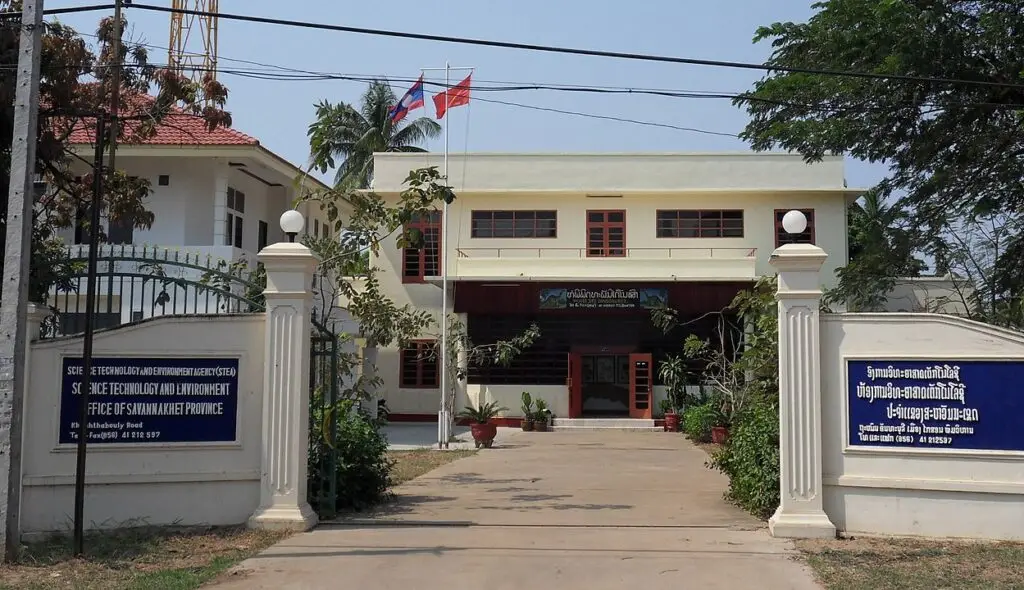
That Ing Hang Stupa, located around 20 minutes outside of the city (15 km), is a Buddhist monument believed to house a relic of Buddha’s spine. Therefore it’s a significant pilgrimage site for Theravada Buddhists. The stupa stands approximately nine meters tall and features intricate carvings and decorations that reflect it’s historical and religious importance. Tradition holds that the site marks the place where Lord Buddha rested during his travels, adding to its spiritual significance. Today, That Ing Hang continues to be an important place of worship for both Laotian and Thai Buddhists, with annual festivals attracting numerous devotees. The stupa was originally built during the reign of King Soumitatham approximately 2,000 years ago to commemorate a visit by Lord Buddha. It was later rebuilt in 1548 by King Sayasetthathilath. Visitors are advised to dress respectfully, with women often required to wear a traditional Lao-style sarong, known as a “pahsin”, before entering the temple grounds.
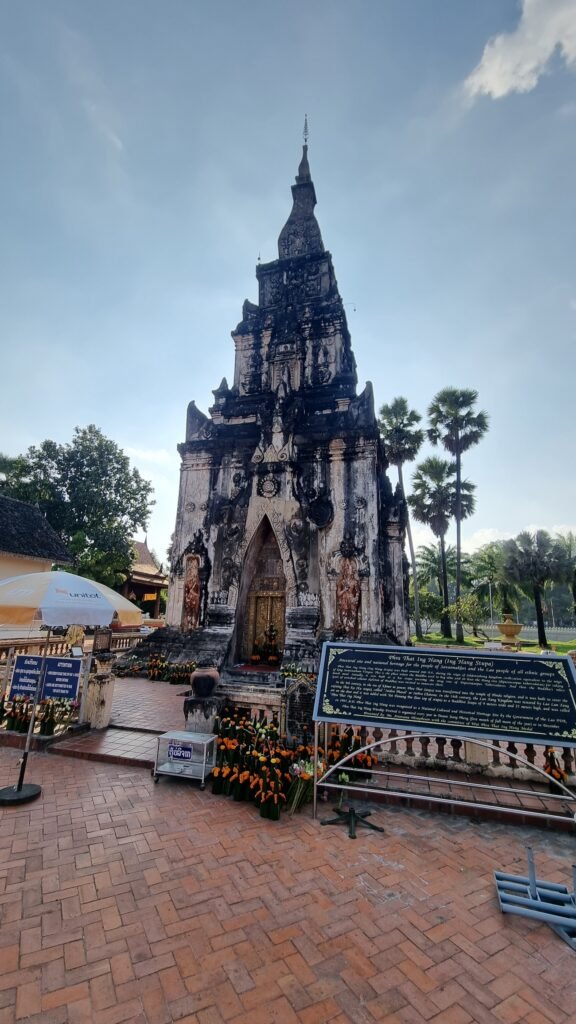
Completely rebuilt by the local government, the new Mekong River Front in Savannakhet is a popular hang out spot for locals. Overlooking Mukdahan in Thailand, in the evening the promenade becomes full of Life. Local families show up with, get some local lao food, delicious Beerlao and enjoy the absolutely beautiful sunset. The river front is right next to the Laochalern Night Market, so it’s perfect for an evening stroll.
The Mekong River Front in Savannakhet is also a great spot for light exercise, with locals jogging or practicing aerobics in the open spaces. Small vendors set up shop along the promenade, selling everything from handmade crafts to refreshing drinks. Occasionally, cultural events and festivals take place here, offering tourists a chance to experience traditional Lao music and dance in a scenic riverside setting.
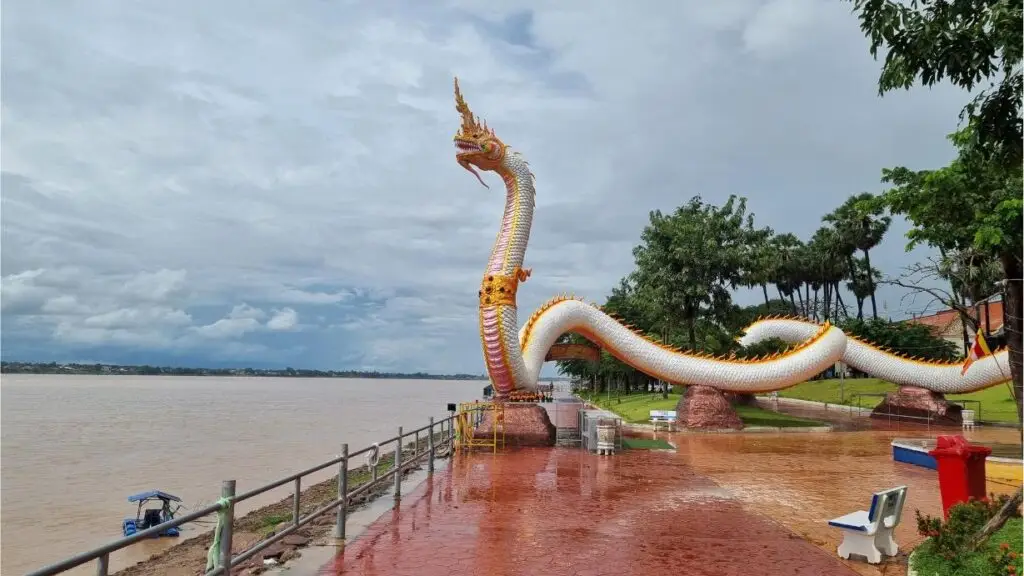
Believe it or not, there is still much more to do in and outside of town. Just a glimpse of what other attractions this central lao city has to offer for it’s visitors.
Doesn’t matter if you’re on a visa run / border bounce from neighbouring Thailand or on the way to south/northern Laos or Vietnam, give Savannakhet a chance. It’s an authentic city, where you still can experience 100% local life instead of an overrun tourist destination. You will not miss anything in this city. There are plenty of coffeeshops with local lao coffee beans from the Bolaven Plateau, great lao, thai, vietnamese and western restaurants, plenty of attractions for for a few days – don’t skip it!